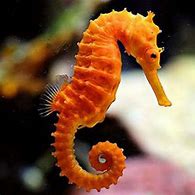
Seahorse
Seahorses are unique and enchanting marine creatures belonging to the family Syngnathidae. They are known for their upright posture, horse-like head, and their fascinating reproductive behaviors. Here are some interesting facts about seahorses:
Appearance: Seahorses have a distinctive appearance with a long snout, a small mouth at the end of their tubular snout, and a body covered in bony plates. They swim in an upright position and use their dorsal fin and pectoral fins for propulsion and steering. Seahorses come in a variety of colors, including shades of yellow, orange, red, brown, and black.
Camouflage: Seahorses have the ability to change color and blend in with their surroundings, providing effective camouflage. They can adjust their coloration to match nearby objects, such as coral reefs or seagrass beds, helping them to hide from predators and ambush their prey.
Habitat: Seahorses are found in shallow tropical and temperate waters around the world. They inhabit a variety of coastal habitats, including seagrass meadows, coral reefs, mangroves, and estuaries. They are usually associated with areas rich in vegetation or structures where they can anchor themselves.
Unique Adaptations: Seahorses have several unique adaptations that set them apart from other fish. One of their most notable adaptations is their prehensile tail, which they use to hold onto objects such as seagrass or coral. They also have a long snout, which they use to probe for food and suck it up into their mouths.
Mating and Reproduction: Seahorses have a fascinating mating system where the males bear the young. During courtship, pairs engage in an elaborate display, often changing colors and performing graceful dances. The female deposits her eggs into a specialized pouch on the male’s belly, where they are fertilized and incubated until hatching. The male then gives birth to live young, releasing miniature seahorses into the water.
Monogamy and Pair Bonding: Many seahorse species exhibit monogamous behavior, forming long-term pair bonds. Once a pair forms, they engage in elaborate courtship rituals and often stay together throughout the breeding season. Some species may even stay together for multiple breeding seasons.
Feeding Habits: Seahorses are carnivorous and primarily feed on small crustaceans, such as copepods and shrimp. They have a unique feeding mechanism where they use their tubular snout to create a suction force to capture prey. Seahorses are known for their slow and deliberate feeding behavior.
Threats and Conservation: Seahorses face numerous threats, including habitat loss, destructive fishing practices, and the exotic pet trade. Their slow reproductive rate and specific habitat requirements make them particularly vulnerable to population decline. Many countries have implemented conservation measures to protect seahorses and regulate their trade.
Cultural Significance: Seahorses have long been regarded as symbols of luck, protection, and strength in various cultures. They are often depicted in art, jewelry, and folklore, representing traits such as patience, persistence, and gracefulness.
Research and Conservation Efforts: Scientists are studying seahorses to better understand their biology, behavior, and conservation needs. Conservation organizations and marine institutes are working to raise awareness about seahorse conservation, implement sustainable fishing practices, and protect their habitats.